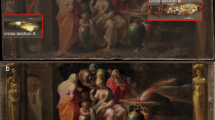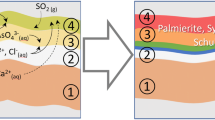Abstract
The chemical and physical alterations of cadmium yellow (CdS) paints in Henri Matisse’s The Joy of Life (1905–1906, The Barnes Foundation) have been recognized since 2006, when a survey by portable X-ray fluorescence identified this pigment in all altered regions of the monumental painting. This alteration is visible as fading, discoloration, chalking, flaking, and spalling of several regions of light to medium yellow paint. Since that time, synchrotron radiation-based techniques including elemental and spectroscopic imaging, as well as X-ray scattering have been employed to locate and identify the alteration products observed in this and related works by Henri Matisse. This information is necessary to formulate one or multiple mechanisms for degradation of Matisse’s paints from this period, and thus ensure proper environmental conditions for the storage and the display of his works. This paper focuses on 2D full-field X-ray Near Edge Structure imaging, 2D micro-X-ray Diffraction, X-ray Fluorescence, and Fourier Transform Infra-red imaging of the altered paint layers to address one of the long-standing questions about cadmium yellow alteration—the roles of cadmium carbonates and cadmium sulphates found in the altered paint layers. These compounds have often been assumed to be photo-oxidation products, but could also be residual starting reagents from an indirect wet process synthesis of CdS. The data presented here allow identifying and mapping the location of cadmium carbonates, cadmium chlorides, cadmium oxalates, cadmium sulphates, and cadmium sulphides in thin sections of altered cadmium yellow paints from The Joy of Life and Matisse’s Flower Piece (1906, The Barnes Foundation). Distribution of various cadmium compounds confirms that cadmium carbonates and sulphates are photo-degradation products in The Joy of Life, whereas in Flower Piece, cadmium carbonates appear to have been a [(partially) unreacted] starting reagent for the yellow paint, a role previously suggested in other altered yellow paints.








Similar content being viewed by others
References
L. Zanella et al., The darkening of zinc yellow: XANES speciation of chromium in artist’s paints after light and chemical exposures. J. Anal. At. Spectrom. 26(5), 1090–1097 (2011)
L. Monico et al., Degradation process of lead chromate in paintings by Vincent van Gogh studied by means of synchrotron X-ray spectromicroscopy and related methods. 2. Original paint layer samples. Anal. Chem. 83(4), 1224–1231 (2011)
L. Monico et al., Degradation process of lead chromate in paintings by Vincent van Gogh studied by means of synchrotron X-ray spectromicroscopy and related methods. 1. Artificially aged model samples. Anal. Chem. 83(4), 1214–1223 (2011)
L. Monico et al., Degradation process of lead chromate in paintings by Vincent van Gogh studied by means of spectromicroscopic methods. 3. Synthesis, characterization, and detection of different crystal forms of the chrome yellow pigment. Anal. Chem. 85(2), 851–859 (2012)
L. Monico et al., Degradation process of lead chromate in paintings by Vincent van Gogh studied by means of spectromicroscopic methods. 4. Artificial aging of model samples of co-precipitates of lead chromate and lead sulfate. Anal. Chem. 85(2), 860–867 (2013)
L. Monico et al., Degradation process of lead chromate in paintings by Vincent van Gogh studied by means of spectromicroscopic methods. Part 5. Effects of nonoriginal surface coatings into the nature and distribution of chromium and sulfur species in chrome yellow paints. Anal. Chem. 86(21), 10804–10811 (2014)
G. Van der Snickt et al., Characterization of a degraded cadmium yellow (CdS) pigment in an oil painting by means of synchrotron radiation based X-ray techniques. Anal. Chem. 81(7), 2600–2610 (2009)
G. Van der Snickt et al., Combined use of synchrotron radiation based micro-X-ray fluorescence, micro-x-ray diffraction, micro-x-ray absorption near-edge, and micro-fourier transform infrared spectroscopies for revealing an alternative degradation pathway of the pigment cadmium yellow in a painting by Van Gogh. Anal. Chem. 84(23), 10221–10228 (2012)
B. Leone et al., The deterioration of cadmium sulphide yellow artists’ pigments, in Triennial meeting (14th), The Hague, 12–16 September 2005: preprints, 2005, ed. by James & James
U. Plahter, B. Topalova-Casadiego, The Scream by Edvard Munch: painting techniques and colouring materials, in Studying Old Master Paintings Technology and Practice, ed. by M. Spring. The National Gallery Technical Bulletin 30th Anniversary Conference Postprints (London: Archetype, 2011), pp. 244–252
J.L. Mass et al., The photodegradation of cadmium yellow paints in Henri Matisse’s Le Bonheur de vivre (1905–1906). Appl. Phys. A 111(1), 59–68 (2013)
C.S. Patterson et al., Synchrotron-based imaging FTIR spectroscopy in the evaluation of painting cross-sections. e-Preserv. Sci. 10, 1–9 (2013)
J. Mass et al., SR-FTIR imaging of the altered cadmium sulfide yellow paints in Henri Matisse’s Le Bonheur de vivre (1905–6)—examination of visually distinct degradation regions. Analyst 138(20), 6032–6043 (2013)
E. Pouyet et al., Thin-sections of painting fragments: opportunities for combined synchrotron-based micro-spectroscopic techniques. Herit. Sci. 3(1), 3 (2015)
E. Pouyet et al., Preparation of thin-sections of painting fragments: classical and innovative strategies. Anal. Chim. Acta 822, 51–59 (2014)
M. Salomé et al., The ID21 scanning X-ray microscope at ESRF. J. Phys. Conf. Ser. 425(18), 182004 (2013)
M. Cotte et al., Blackening of Pompeian Cinnabar paintings: X-ray microspectroscopy analysis. Anal. Chem. 78(21), 7484–7492 (2006)
V.A. Sole et al., A multiplatform code for the analysis of energy-dispersive X-ray fluorescence spectra. Spectrochim. Acta Part B At. Spectrosc 62(1), 63–68 (2007)
B. Fayard et al., The new ID21 XANES full-field end-station at ESRF. J. Phys. Conf. Ser. 425(19), 192001 (2013)
Y. Liu et al., TXM-Wizard: a program for advanced data collection and evaluation in full-field transmission X-ray microscopy. J. Synchrotron Radiat. 19(2), 281–287 (2012)
U. Boesenberg et al., Mesoscale phase distribution in single particles of LiFePO4 following lithium deintercalation. Chem. Mater. 25(9), 1664–1672 (2013)
C.G. Schroer et al., Hard X-ray nanoprobe at beamline P06 at PETRA III. Nucl. Instrum. Methods Phys. Res. Sect. A 616(2–3), 93–97 (2010)
W. De Nolf, F. Vanmeert, K. Janssens, XRDUA: crystalline phase distribution maps by two-dimensional scanning and tomographic (micro) X-ray powder diffraction. J. Appl. Crystallogr. 47(3), 1107–1117 (2014)
J. Kieffer, D. Karkoulis, PyFAI, a versatile library for azimuthal regrouping, in Journal of physics: conference series (IOP Publishing, 2013)
J. Susini et al., Why infrared spectromicroscopy at the ESRF? ESRF Newsl. 41, 24–25 (2005)
D. Saviello et al., Synchrotron-based FTIR microspectroscopy for the mapping of photo-oxidation and additives in acrylonitrile–butadiene–styrene model samples and historical objects. Anal. Chim. Acta 843, 59–72 (2014)
Acknowledgments
This work is supported by the Andrew W. Mellon Foundation, the Barnes Foundation, the Lenfest Foundation, and the National Science Foundation DMR 0415838. The European Synchrotron Radiation Facility are acknowledged for providing beamtime. Barbara Buckley of the Barnes Foundation and Unn Plahter of the University of Oslo are thanked for their many helpful discussions.
Author information
Authors and Affiliations
Corresponding author
Electronic supplementary material
Below is the link to the electronic supplementary material.
Rights and permissions
About this article
Cite this article
Pouyet, E., Cotte, M., Fayard, B. et al. 2D X-ray and FTIR micro-analysis of the degradation of cadmium yellow pigment in paintings of Henri Matisse. Appl. Phys. A 121, 967–980 (2015). https://doi.org/10.1007/s00339-015-9239-4
Received:
Accepted:
Published:
Issue Date:
DOI: https://doi.org/10.1007/s00339-015-9239-4




